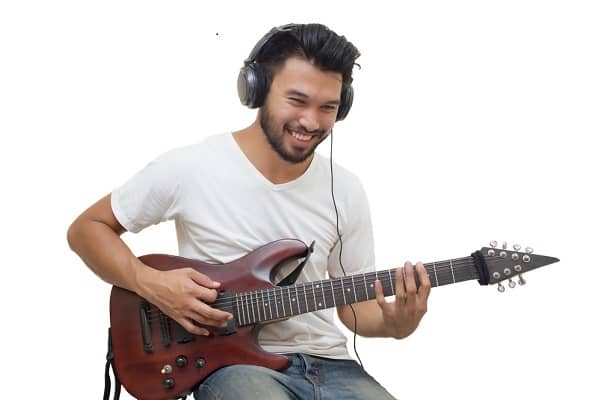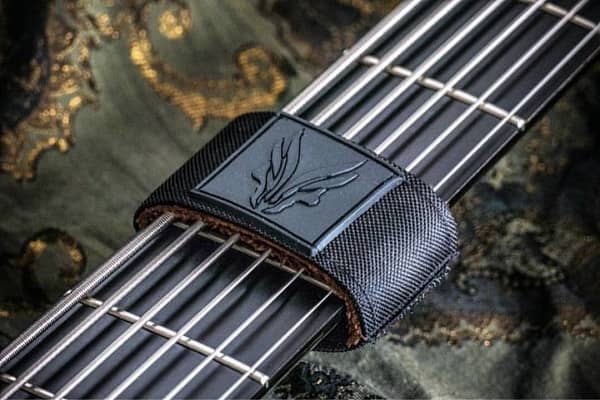It takes regular practice to improve at any instrument, and the guitar is no exception. Whether you’re a young player just learning the basics or a more experienced guitarist working to reach that next plateau, careful, regular practice is the key to progress.
Guitar, even acoustic guitar, can be a loud instrument, though, and finding an appropriate time to practice guitar techniques can be challenging. So, how can we reconcile our need to improve our playing with our desire to be good partners, roommates, and neighbors?
In this guide, you’ll understand how to practice and play guitar quietly without disturbing the peace.
How To Practice Electric Guitar Quietly
Unlike most musical instruments, there are several ways to practice and play guitar quietly. Whether you play primarily acoustic or electric guitar, the following tips will help you improve your skills without waking your parents, girlfriend, or the grumpy old lady in the apartment beneath yours.
Play Without Amplification
Playing the electric guitar without amplification produces far less sound than a softly strummed acoustic guitar. What’s more, the sound produced is mainly treble, which has a harder time penetrating walls than does bass. The sound it makes is entirely audible, which is why this is one of the easiest ways to practice guitar techniques silently.
I keep my guitar hanging on the wall beside my desk, and when the spirit grabs me at two in the morning, I find playing unplugged (without a guitar amp) more than adequate for late-night guitar practice or composition.
Play Through A Battery-Powered Mini Amp

You’ve seen them in the guitar store or online: those tiny amplifiers that look like someone hit a Marshall combo with a shrink-ray. These small, portable, battery-powered amps are produced by a variety of the world’s top amplifier brands and deliver a surprisingly quality sound.
While battery-powered mini amps can be played at a lower volume than many larger amps, they still amplify sound. Before practicing guitar with a battery-powered amp in the dead of night, experiment a bit, and see how far the sound travels at the lowest volume.
If you live with a light sleeper and even a battery-powered amp on the lowest volume setting disturbs them, don’t end the relationship just yet. Another way of playing electric guitar quietly without sacrificing the guitar’s volume or digital effects is to play using headphones.
Practice Quietly Using Headphones

Playing without an amp or playing through a battery-powered mini guitar amp are both great ways to practice or compose without disturbing others. But what if you’re learning pinch-harmonics, are trying to master sweep-picking, or need to improve your wah-pedal prowess?
Odds are, in such cases, you’ll want to practice with headphones. While I probably play unamplified more often out of expediency, I have to admit using headphones is my favorite way to practice electric guitar quietly.
To experience the joy of tearing through your favorite riff, lick, or solo at full volume and with your favorite effects, simply plug your headphones or earbuds into the output jack on your amplifier, modern multi-effects pedal, or modeling processor.
If your earbuds have a one-eighth plug and your amp has a one-quarter jack (or vice-versa), you’ll need to purchase an inexpensive converter. They’re only a few dollars and well worth the investment in your guitar playing.
Practice Using A Mini Amp Sim Device

The vast majority of amplifiers come with audio-output jacks. If yours doesn’t, or you’re looking for more portability as you practice, you might consider using a mini amp simulator device.
Mini amp sim devices or pocket-sized headphone amps eliminate the need for full-size amps, guitar cables, and effects pedals, freeing up sessions to maintain your practice routine.
Designed to plug right into your guitar’s input jack, sim devices come in many varieties modeled after different amplifiers. Once you’re connected, plug your headphones or earbuds into the audio-out jack and get after it.
These devices are generally quite highly rated, come with loads of effects, including the basics like reverb, chorus, and delay, and are relatively inexpensive too. I would definitely recommend guitarists add these handy tools to their rigs for silent guitar practice capabilities.
Recently, I tested the Fender Mustang Micro headphone amp and was very impressed with its sound quality, variety of amp models and effects, and connectivity features.
The Vox Amplug is another good option – it’s a simpler and more budget-friendly portable headphone amp that also enables quiet practice anywhere.
Play Through Recording Software
There’s one more way to play guitar quietly, and that’s to play through recording software. Many guitarists today, including myself, enjoy playing and composing using digital recording software. To do so, you’ll need to purchase a guitar midi-interface.
A guitar midi-interface, simply put, allows you to plug your electric guitar or bass directly into your computer. There are many on the market, including some, like GarageBand, that are designed for use by guitarists.
Once you’ve got your midi-interface, you’ll need recording software, which can be a significant investment.
Fortunately, we’re not looking to produce an album (yet, anyway), so we don’t need all the bells and whistles offered by premium brand recording software. A shareware recording platform like Audacity is free to download and use.
It probably doesn’t make sense to buy a midi-interface just to practice the electric guitar quietly, but if you own one or have been planning to buy one, most come with headphone jacks (and if they don’t, your studio monitors likely will.)
How To Play Acoustic Guitar Quietly
If you’re wondering how to play guitar quietly in your apartment, but the loud acoustic guitar is your ax of choice, don’t worry; there are just as many ways to play acoustic guitar quietly.
Check out the following tips on how to play guitar that only you can hear if acoustic folk, blues, rock, or classical is your jam.
Dampen Your Guitar’s Sound With A Clothing Item
One effective way of quieting your acoustic practice or playing session is to very gently stuff a t-shirt or two into the soundhole of your instrument. Crazy as it may sound, this is a great, inexpensive way to dampen the volume of your acoustic practice.
A word of caution: Anything larger or bulkier than a t-shirt may be challenging to remove and may even damage your beloved guitar. A sweater, for example, would dampen sound far better than a few t-shirts, but is it worth the risk to your instrument? I would say definitely not.
On the flip side, anything smaller than a t-shirt is likely to prove less effective, and none of us want to waste valuable practice time trying to fish socks or washcloths out of our guitars.
Practice Using A Feedback Dampener

If you’re willing to make a small investment in your playing (and practicing,) consider purchasing an acoustic guitar feedback dampener. These devices, which are inexpensive and designed to fit into the soundhole of your acoustic guitar, significantly reduce the volume of the instrument.
More importantly, acoustic guitar dampeners significantly reduce the bass quality of the sound produced. As mentioned earlier, it’s those pesky bass notes that penetrate walls with such ease.
Try Using An Acoustic Guitar Silencer
If an acoustic feedback dampener doesn’t reduce your volume enough for you to practice late at night or in the wee hours of the morning, try an acoustic guitar silencer/ string mute dampener/ string muter instead.

Unlike a feedback dampener, an acoustic guitar silencer works by muting the strings. The advantage is you’ll be able to practice your chords, progressions, and scales in near-absolute silence.
The downside is silencers can make it difficult for even the player to hear what he’s playing.
Slide an acoustic guitar silencer (or a similarly sized piece of foam) between the body of your guitar and the strings, butted against the bridge to practice in near-complete quiet.
Consider A Silent Travel Guitar
You’ve probably seen them before, those strange-looking, compact-bodied, headless acoustic and electric guitars. If you’ve ever wondered why anyone would buy one, you aren’t alone.

It turns out, though, these little travel axes are a fantastic way to practice acoustic guitar in relative silence. Perfect for grabbing an hour or two of practice in a hotel bedroom or at home late at night, these guitars are small, light, and compact.
Because they don’t have hollow bodies and soundholes, silent travel guitars produce about as much sound as an unplugged electric guitar.
Silent travel acoustic guitars come both in nylon-string and steel-string, and also can be found in electric guitar styles. Find out more about the silent acoustic guitar in this guide.
Practice Using Palm-Muting
Palm-muting is a guitar technique used to deaden the natural sustain of the instrument. Think Van Halen’s “Ain’t Talking ‘Bout Love,” or Survivor’s “Eye of the Tiger.” Palm-muting produces an interesting, compelling sound and can also be used to practice your acoustic guitar quietly.
The downside of practicing while palm-muting is you won’t be able to practice chords very effectively. You can still practice scales and fret-hand techniques, which should be a significant part of any guitarist’s practice regimen.
If your palm-muted acoustic guitar is still too loud to practice without disturbing others, try sliding your muting hand further from the bridge of your guitar. The further your palm is from the bridge, the less sound will be produced by the guitar.
For more details, check this tutorial video on guitar palm muting and strumming:

Consider Your Practice Space
If you’ve tried the tips listed above, but your acoustic practice is still disturbing your loved ones or neighbors, maybe it isn’t how you’re practicing, but where?
Take a good look around your practice space. Are there bare wood or tile floors? Is the room full and furnished, or generally empty? Is it a large room, or on the smaller side?
All of these considerations can make a big difference to the amount of sound that escapes your practice room. A large, empty space with bare floors and walls is the last place you should be trying to practice quietly. Instead, if possible, practice in a smaller, carpeted area.
Hanging blankets against the walls of the room where you practice is a great way to deaden sound and reduce natural reverb.
Keep in mind, though, that a space outfitted with blankets, or even acoustic tiling, is not soundproofed. Soundproofing is an entirely different process that produces completely different results.
Practice Without A Guitar (No, Seriously)
So far, we’ve looked at several ways to practice the acoustic and electric guitar quietly. But did you know you can practice anywhere, on the train, on line at the store, or in a crowd of people without troubling anyone?
The trick to pulling off this seemingly impossible feat is very simple: practicing without the guitar. Here are a few suggestions on how to turn downtime into practice time.
Run Through Your Fingerings

A great way to practice guitar without a guitar is to go through the motions, so to speak. Playing a stringed instrument actually changes the physiology of the brain enough that, post-mortem, a stringed instrument player can be identified by their brain alone.
Interestingly, we first learned this because Albert Einstein played violin.
In other words, simply repeating and reinforcing the muscle movements involved in playing chords and scales will eventually create subconscious subroutines that will make playing them effortlessly.
For beginners, this means focusing on chord forms. Even if you only know two chords, practicing forming them in the air (or on a small block of wood) can be beneficial. Personally, I use my train time to go through the fingerings of my go-to scales and whichever new scale I’m working on mastering.
It’s possible to practice picking without a guitar, too, though, for the most part, I’d advise saving that for when you have a guitar handy.
Perfect Your Pitch (Ear Training)
Every guitarist can improve by learning to discern pitch. While few of us will ever achieve a perfect pitch, you need not achieve perfection to benefit from an improved pitch.
Identifying a note by sound helps a guitarist transcribe music, play by ear, and play with other musicians. The ability to distinguish the distance between tones (a third, for example, or a fifth) will also allow you to create beautiful harmonies practically on the spot.
The best way to perfect pitch is likely the old-fashioned way, with a piano and instructor. For a more portable learning experience, you can visit apps and websites that are designed to improve your pitch.
Using headphones, you’ll be able to try and identify notes and the intervals between them in a game-like format.
Work On Your Finger And Grip Strength
Playing the guitar well requires finger and grip strength. Holding bar chords for the duration of a song will test any new guitarist’s skill. To keep your fingers and grip ready for a three-song medley at all times, consider buying a grip trainer and finger trainer. Both are inexpensive and available online.
Grip and finger trainers are completely silent and can be used just about anywhere without disturbing those nearby. I’ve made grip and finger training a regular part of my practice.
Finger trainers are available at your local guitar store or online dealer, and grip trainers can be purchased anywhere exercise equipment is sold.
Final Words
So, there you have it, a complete guide to practicing your guitar without losing friends and alienating people. Now, if you’ll excuse me, it’s practice time.
What method do you find most effective for quiet guitar practice? Do you have any other handy tricks to allow noise-free sessions? Share your thoughts and favorite techniques in the comments below!
About the Author
Thomas M., the founder of Guitar Top Review, boasts 15+ years of guitar experience and was a church band member in L.A. Transitioning from piano to acoustic guitar, his first love remains his Taylor GS Mini. Alongside like-minded hobbyist friends, he launched the site, driven by a deep love for music that transcends professional boundaries.


